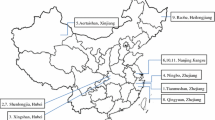Abstract
Ten species of the Monocelidinae have been examined. All were found to be regularly diploid. Four of them show the chromosome number n=3 and remarkably similar karyotypes (one pair of large metacentrics, one pair of medium sized metacentrics and one pair of small heterobrachial chromosomes). This set is considered as basic (plesiomorphic) for the family Monocelididae. Three species present n=4 and three species n=5, with an increase of heterobrachial chromosomes. Based on karyometrical data, it is suggested that these complements are derived from the basic complement through fission of one or both metacentric chromosomes, respectively. Further minor chromosome rearrangements, involving centromere position, were observed.
Similar content being viewed by others
References
Benazzi, M., 1982. Speciation events evidenced in Turbellaria. In: Mechanisms of speciation. (C.Barigozzi, ed.) pp. 307–344. Alan R. Liss Inc., New York.
Benazzi, M. & Benazzi Lentati, G., 1976. Platyhelminthes. In: Animal cytogenetics (B.John ed.) Vol. 1: 1–182. Borntraeger, Berlin-Stuttgart.
Bickham, J. W. & Baker, R. J., 1979. Canalization model of chromosomal evolution. In: Models and methodologies in evolutionary theory (J. H. Schwartz & H. G. Rollins, eds) 13: 70–84. Bull. Carnegie Mus. Nat. Hist.
Curini-Galletti, M., Galleni, L. & Puccinelli, I., 1984a. Karyological analysis of Monocelis fusca, M. lineata (Monocelididae) and Parotoplana macrostyla (Otoplanidae). Helgolander Meeresunters. 37: 171–178.
Curini-Galletti, M., Galleni, L., Martens, P. M., Puceinelli, I. & Schockaert, E., 1984b. Karyological observations on Turbellaria Proseriata. Boll. Zool. 51 (Suppl.): 35.
Curini-Galletti, M., Martens, P. M. & Puccinelli, I., 1985. Karyological observations on Monocelididae (Turbellaria, Proseriata): Karyometrical analysis of four species pertaining to the subfamily Minoninae. Caryologia 38: 67–75.
Galleni, L. & Puccinelli, I., 1986. Chromosomal evolution in marine triclads and polyclads (Turbellaria). Hydrobiologia 132: 239–242.
Karling, T. G., 1956. Morphologisch-histologische Untersuchungen an den männlichen Atrialorganen der Kalyptorhynchia (Turbellaria). Ark. Zool. (2) 9: 187–279.
Karling, T. G., 1966. Marine Turbellaria from the Pacific coast of North America. Coelogynoporidae and Monocelididae. Ark. Zool. 18: 493–528.
Karling, T. G., 1978. Anatomy and systematies of marine Turbellaria from Bermuda. Zool. Scr. 7: 225–248.
King, M., 1984. Karyotypic evolution in Gehyra (Gekkonidae: Reptilia). IV. Chromosome change and speciation. Genetica 64: 101–114.
Levan, A., Fredga, K. & Sandberg, A. A., 1964. Nomenclature for centromeric position on chromosomes. Hereditas 52: 201–220.
Martens, P. M., 1983. Three new species of Minoninae (Turbellaria, Proseriata, Monocelididae) from the North Sea, with remarks on the taxonomy of the subfamily. Zool. Scr. 12: 153–160.
Martens, P. M., 1984. Comparison of three different extraction methods for Turbellaria. Mar. Ecol. Progr. Ser. 14: 229–234.
Martens, P. M. & Curini-Galletti, M. C., 1987. Karyological study of three Monocelis-species, and description of a new species from the Mediterranean, Monocelis longistyla sp.n. (Monocelididae, Plathelminthes). Microfauna marina 3: 297–308.
Martens, P. M., Curini-Galletti, M. C. & Puccinelli, I., 1989. On the morphology and karyology of the genus Archilopsis (Meixner). Hydrobiologia (in press).
Martens, P. M., Curini-Galletti, M. C. & VanOostveldt, P., 1985. Comparative karyology and scanning cytophotometric DNA measurements of Proseriata (Turbellaria): with phylogenetic conclusions. Annls Soc. r. zool. Belg. 115 (2): 241.
McGregor, H. C., 1981. Big chromosomes and speciation amongst Amphibia. In: Genome evolution. (G. A.Dover & R. B.Flavell, eds) pp. 325–341. Academic Press, New York.
Stirewalt, N. A. M., Kepner, W. A. & Fergusson, F. F., 1940. A new Turbellarian worm ‘Alleocoela’ from Beaufort, North Carolina, Archiloa wilsoni n.sp. J. Elisha Mitchell Scient. Soc. 65 (1): 123–133.
White, M. J. D., 1978. Modes of speciation. 455 pp. W. H. Freeman & Co., San Francisco.
Author information
Authors and Affiliations
Rights and permissions
About this article
Cite this article
Curini-Galletti, M.C., Puccinelli, I. & Martens, P.M. Karyometrical analysis of 10 species of the subfamily Monocelidinae (Proseriata, Platyhelminthes) with remarks on the karyological evolution of the Monocelididae. Genetica 78, 169–178 (1988). https://doi.org/10.1007/BF00055635
Received:
Accepted:
Issue Date:
DOI: https://doi.org/10.1007/BF00055635




